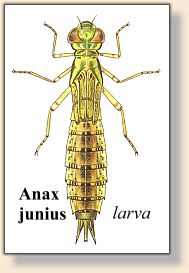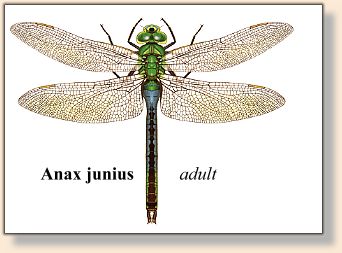Damselflies and Dragonflies are both members of the order Odonata.
They are found in the same locations, so where you find one of
the group you will probably find the other.

The main differences between the two are distinguishable as larva because of
the tail structure. The Damselflies (right) have 3 leaflike caudals in place of a tail. The
insect uses these caudals like paddles to propel itself. The Dragonflies do not
have a tail, but 3 very short stubs. While larval coloration of either is similiar, the
big difference to the fly fisher is how they each propel themselves. The Damselfly
'nymph' swims, with a motion like a minnow.
The Dragonfly (below) has a very different digestive system, and is capable of expelling
gas from its anus (or drawing water in and then expelling it) so the motion of
the Dragonfly is in short spurts, literally jet propulsion. (Similiar to the motion
of a squid.)

As adults Dragonflies hold their wings to the sides when they are at rest.
While the Damselflies at rest have their wings are folded over their back.
Both have compete chewing mouth parts and are very aggressive. The dragonfly
shown below, is common throughout the United States and southern Canada,
known as the Common Green Darner.

Dragonflies and Damselfly are unable to fold their wings (4) back over their
abdomen, a shared trait with mayflies. The order to which they belong
Odonata is found world-wide, especially in the tropics,
and is among the largest of aquatic groups. The adults are well known for
their beautiful colors, flying ability and curious habits. They have been the
object of poems, art, jewelry and even childrens stories.
Color variation runs from brown and black with very little wing color to bright
iridescent blues and greens to even brighter red and ruby damselflies found along the Fire
Hole River in Yellowstone National Park.
Adults may live from a few weeks to a few months. The emerging adult is not fully colored nor
sexually mature. The young adults are known as tenerals, and are clumsy and easy targets for
preditors. Once the insect is mature, the males stake out territories and partition their flying
space for reproduction, feeding or both.
The depositing of eggs doesn't give fish much of a shot at them. The ovipositing is done in
emerging or floating plants, sometimes on dry land which will be flooded in the spring.
The nymphs crawl out like stoneflies, or crawl up vegetation so lake and pond
edges are prime habitate. You should retrieve you fly toward
shore. These are important food sources for all fish. Depending of
the size of your local insects, the nymphs (such as the large
Eastern Paddletail) should be weighted and fished with slight periodic
jerking methods - (remember the jet propulsion?) - on the bottom of
slow or moderately flowing waters. The American Ruby Spot Damselfly
(below) is available mid-June through October in the Midwest.
 This one is easy. If you see any you probably have both the emerging,
tenerals, and adults all at the same time. ~ DLB
This one is easy. If you see any you probably have both the emerging,
tenerals, and adults all at the same time. ~ DLB
For more on Damsels and Dragons and Extended Body Damsels
click here. For the
nymph, see the Blue
Mountain Dragon Nymph, the
Woven Dragonfly Nymph,
or the Flicted Damselfly Nymph.
Credits: All illustrations from Aquatic Entomology by W.
Patrick McCafferty, published by Jones and Barlett.
|







